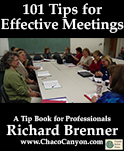Meeting Madness Skip to the Details:
How To Orderafflicts almost every organization.
And as we make more use of dispersed teams and outsourcing, we become increasingly dependent on
meetings, because of the more limited opportunities for casual communication. If we ever find
our way out of this meeting mess, we can be sure that making meetings more effective, less
numerous and shorter will be features of the solution. This tip book shows you how.
 In
my own experience, and in the course of working with clients in my consulting and coaching
practices, I've learned a lot about what works and what doesn't when we try to make meetings
more effective. Some of what I've learned is just good practice and has appeared in the
literature over the years. But much is very new, developed in response to the rapid structural
and technological change that has swept through today's office.
In
my own experience, and in the course of working with clients in my consulting and coaching
practices, I've learned a lot about what works and what doesn't when we try to make meetings
more effective. Some of what I've learned is just good practice and has appeared in the
literature over the years. But much is very new, developed in response to the rapid structural
and technological change that has swept through today's office.
This tip book is both like and unlike many other collections of ideas for effective meetings. Like others, it's packed with ideas and suggestions that will reduce the time you spend in meetings, and make the time you do spend in meetings much more productive and less stressful.
Unlike others, this tip book also provides suggestions for organizational leaders — ideas for adjusting the organizational culture to support meeting effectiveness, while at the same time reducing the need for meetings.
Some sample tips
Here's a sample:
- Have a Not-Agenda
- Include with the agenda a not-agenda: a list of topics that are off limits for this meeting. Indicate when these items might be expected to be on a future agenda.
- Stay away from your subordinates' meetings
- Rarely is visiting a subordinate's meeting a good idea. The risk of disrupting the meeting is high, but your visit can even disrupt relationships between the meeting participants.
- Manage the burden of meetings
- Measure the average percentage of time that people in your organization spend in meetings. Use cleverness, creativity and brainpower to try to drive it lower.
- Have too many conference rooms
- If you have too few conference rooms, people feel compelled to book them far in advance, which creates a false need for regular meetings, which in turn increases the demand for conference rooms. If you ever notice that all the conference rooms are booked, create more.
- Limit presentations to 15 minutes
- Since no meeting should go more than 90 minutes, presentations that run longer than 15 minutes significantly cut into the time available for discussion. If you want people to hear a longer presentation, schedule a presentation, not a meeting.
Table of contents
Here's a chapter-by-chapter summary of what you'll find in this book.
Click the folder icons to reveal (or hide) individual chapter content summaries, or:
- 1Poll for agenda items before you announce the agenda
- 2Circulate the agenda in advance
- 3Focus the agenda
- 4Have a Not-Agenda
- 5Clearly define the meeting's objectives
- 6Post the agenda during the meeting
- 7Make the first item "Review Agenda"
- 8Use a parking lot
- 9Invite everyone you need
- 10Don't invite people you don't need
- 11Consider inviting a facilitator
- 12Consider inviting interpreters
- 13Have some people on call
- 14Stay away from your subordinates' meetings
- 15Beware ex-officios
- 16Manage the burden of meetings
- 17Give each person enough space
- 18For small meetings, use a round table
- 19Chair from a central location
- 20Chair from the sweet spot
- 21For large meetings, use a mic
- 22Consider movable furniture
- 23Set an appropriate temperature
- 24Choose the day of the week carefully
- 25Choose the start time carefully
- 26Start on time
- 27Use multiple media to announce changes or cancellations
- 28Eliminate lunch meetings
- 29Avoid the hour right after lunch
- 30Try to get 11:00 am
- 31Limit the length of your meetings
- 32Limit presentations to 15 minutes
- 33Limit discussions to 30 minutes
- 34Stay out of the rabbit hole
- 35Designate someone as a Digression Detector
- 36Learn from digressions
- 37Allocate time for puzzles
- 38If an item runs over, suspend it or review the agenda
- 39Hold some time in reserve
- 40Schedule the next meeting in email
- 41For a regular meeting, have ground rules
- 42Consider special needs
- 43Take personal responsibility
- 44Halt all sidebars
- 45Don't characterize the positions of others
- 46Value some kinds of interruptions
- 47Value opposition
- 48Be creative in resolving debates
- 49Accept suggestions without strings
- 50Have too many conference rooms
- 51Avoid "serial-status-report"
- 52Circulate handouts well in advance
- 53If things get heated, declare a three-exchange dialog
- 54If you get near the boiling point, take a brief silent break
- 55If you see a pile-up, call a halt
- 56Watch for trips to Abilene
- 57Ask the tough questions
- 58Stop sidebars
- 59Take milling-about breaks
- 60Distinguish problem solving from problem defining
- 61For handouts, print at least two slides per page
- 62Know when to halt
- 63Use technology appropriately
- 64Think before you PowerPoint
- 65Avoid playing PowerGeek
- 66Check your hardware at the door
- 67Ban texting
- 68Expect to get less done
- 69Recognize that teleconferences have limitations
- 70Set alternate times, places, and phone numbers
- 71Send support materials ahead
- 72Say your name whenever you speak
- 73Use the name of the person you're addressing
- 74Leave the food behind
- 75Have a networked computer handy
- 76Consider using a scribe at every site
- 77Follow the "anchor handoff" protocol
- 78Speak slowly
- 79If your site is just listening, mute the phone
- 80Mute your cell phone
- 81Mute your speakerphone
- 82If you use the hold button, mute the music
- 83Get teleconference training
- 84Use Zulu time in meeting announcements and reminders
- 85Rotate the meeting site
- 86Choose site names carefully
- 87Distribute the travel
- 88Rotate the location of the chair or facilitator
- 89Beware excessive focus on travel costs
- 90Circulate minutes within a day
- 91Circulate minutes to stakeholders
- 92Use the attendance list to thank participants
- 93Use a flipchart for minutes
- 94Capture the meaning, not the words
- 95Look in the rear-view mirror
- 96Reach a conclusion on each agenda item
- 97Track action items
- 98Have an owner for each action item
- 99Set a date for each action item
- 100Use a three-state status system for action items
- 101Treat late action items specially
- 102Track open issues
- 103Capture the parking lot
What readers say
Here's a sample of reader's comments:
- You're stuff is brilliant! And — Thank you for sharing these ideas.
- You and Scott Adams both secretly work here, right?
- The articles are great, I enjoy getting them, and you always have something very interesting to say, or good points to raise.
- I really enjoy my weekly newsletters. I appreciate that the newsletter is a quick read and is much more intellectually stimulating than, say, reading a Dilbert cartoon.
- You fill a need that went unmet — a sort of Dr. Phil for Management!
- I have found your articles extremely accurate, inspiring and applicable to day-to-day. You have a great writing style and the lessons that you have shared with us are invaluable.
- More
Designed for busy people
Most of us have way too much to do to find much time to read. And the time we do have is broken up into small chunks. We need the knowledge, but too often, we don't have time to get it, and we can't wade through 15-page chapters that lay out lengthy discussions.
Knowledge products from Chaco Canyon Consulting are designed with busy people in mind. Here are some features that make reading our e-books fast and convenient.
- They're available on line
- It's fun to go to a bookstore, but you have to find the time to go to the store, find what you want, wait in line to pay for it, and get back from the store. For some of us, all that time is a challenge.
- With our knowledge products, you browse for your selection on line, and pay for it quickly and easily through ClickBank. You can do it anywhere that has an Internet connection.
- Instant downloads
- With some on-line stores, you have to wait for an email message with download instructions. The wait can be brief, but sometimes it's a day or so.
- With our knowledge products, receive download instructions instantly. After you select an item, you can have it in your possession in minutes.
- Universal data formats
- To use some on-line knowledge products, even those you download, you need a computer or mobile device, or worse—a computer with a specific operating system.
- Our knowledge products are available in near-universal formats—either hypertext (like this document you're reading right now), or Acrobat (PDF), or MP3. You can use them with any computer or device that supports the format of that product (either hypertext, PDF or MP3).
- Written for busy people
- Most business books are about 200-250 pages, with about 10 chapters. I don't know about you, but I don't have time to read a 225-page book cover-to-cover. There are lots of folks like us—that's why there's such a booming market in book condensations.
- Our ebooks cut out that middle step. They're designed to be read by people who don't have time for the typical business book. Our tip books consist of short paragraphs, two- to four sentences per tip. Each tip has a headline in bold. You can easily scan the book for tips that seem relevant to you and read only those. Read in any order, and read them in short sittings.
- We use hyperlinks
- Most books, even e-books, are meant to be read off-line. Because they stand alone, they contain material that you might not want to see.
- Our ebooks assume that you have the Internet nearby. If you want background material on a point we've made, just click. And some of our hyperlinks link to other places in the e-book itself, to help you tie things together is you read.
Details and how to order
After your purchase is approved, ClickBank presents a page that contains a link to a page where you can download your item immediately. You can load it onto your computer or mobile device, or print it. Your satisfaction is guaranteed by ClickBank's return policy.
Price: per copy.
Quantity packs are available at the prices shown below. Call for site license pricing at the phone number below.
| Order 101 Tips for Effective Meetings by credit card, for USD 7.77 each, using ClickBank.com. . |
